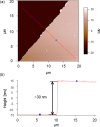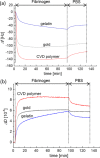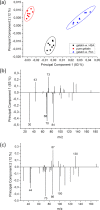Interaction of human plasma proteins with thin gelatin-based hydrogel films: a QCM-D and ToF-SIMS study
- PMID: 24956040
- PMCID: PMC4215905
- DOI: 10.1021/bm500750v
Interaction of human plasma proteins with thin gelatin-based hydrogel films: a QCM-D and ToF-SIMS study
Abstract
In the fields of surgery and regenerative medicine, it is crucial to understand the interactions of proteins with the biomaterials used as implants. Protein adsorption directly influences cell-material interactions in vivo and, as a result, regulates, for example, cell adhesion on the surface of the implant. Therefore, the development of suitable analytical techniques together with well-defined model systems allowing for the detection, characterization, and quantification of protein adsorbates is essential. In this study, a protocol for the deposition of highly stable, thin gelatin-based films on various substrates has been developed. The hydrogel films were characterized morphologically and chemically. Due to the obtained low thickness of the hydrogel layer, this setup allowed for a quantitative study on the interaction of human proteins (albumin and fibrinogen) with the hydrogel by Quartz Crystal Microbalance with Dissipation Monitoring (QCM-D). This technique enables the determination of adsorbant mass and changes in the shear modulus of the hydrogel layer upon adsorption of human proteins. Furthermore, Secondary Ion Mass Spectrometry and principal component analysis was applied to monitor the changed composition of the topmost adsorbate layer. This approach opens interesting perspectives for a sensitive screening of viscoelastic biomaterials that could be used for regenerative medicine.
Figures







Similar articles
-
Viscoelastic properties of fibrinogen adsorbed onto poly(ethylene terephthalate) surfaces by QCM-D.Carbohydr Polym. 2013 Mar 1;93(1):246-55. doi: 10.1016/j.carbpol.2012.02.075. Epub 2012 Mar 23. Carbohydr Polym. 2013. PMID: 23465926
-
Characterizing multicomponent adsorbed protein films using electron spectroscopy for chemical analysis, time-of-flight secondary ion mass spectrometry, and radiolabeling: capabilities and limitations.Biomaterials. 2003 May;24(11):1897-908. doi: 10.1016/s0142-9612(02)00612-9. Biomaterials. 2003. PMID: 12615480
-
What is really driving cell-surface interactions? Layer-by-layer assembled films may help to answer questions concerning cell attachment and response to biomaterials.Biointerphases. 2016 Mar 10;11(2):019009. doi: 10.1116/1.4943046. Biointerphases. 2016. PMID: 26964531
-
Label-free, real-time interaction and adsorption analysis 2: quartz crystal microbalance.Methods Mol Biol. 2013;996:313-22. doi: 10.1007/978-1-62703-354-1_18. Methods Mol Biol. 2013. PMID: 23504432 Review.
-
Quartz crystal microbalance: a useful tool for studying thin polymer films and complex biomolecular systems at the solution-surface interface.Biomacromolecules. 2003 Sep-Oct;4(5):1099-120. doi: 10.1021/bm020116i. Biomacromolecules. 2003. PMID: 12959572 Review.
Cited by
-
Bioactive Functional Nanolayers of Chitosan-Lysine Surfactant with Single- and Mixed-Protein-Repellent and Antibiofilm Properties for Medical Implants.ACS Appl Mater Interfaces. 2021 May 26;13(20):23352-23368. doi: 10.1021/acsami.1c01993. Epub 2021 May 17. ACS Appl Mater Interfaces. 2021. PMID: 33998809 Free PMC article.
-
Gelatin Adsorption onto Cellulose Nanocrystals Surfaces at Different pH: A QCM-D Study.Langmuir. 2025 Jun 24;41(24):15319-15330. doi: 10.1021/acs.langmuir.5c00795. Epub 2025 Jun 10. Langmuir. 2025. PMID: 40492952 Free PMC article.
-
Polymeric Gelatin Scaffolds Affect Mesenchymal Stem Cell Differentiation and Its Diverse Applications in Tissue Engineering.Int J Mol Sci. 2020 Nov 16;21(22):8632. doi: 10.3390/ijms21228632. Int J Mol Sci. 2020. PMID: 33207764 Free PMC article.
-
Cyclic Adenosine Monophosphate-Enhanced Calvarial Regeneration by Bone Marrow-Derived Mesenchymal Stem Cells on a Hydroxyapatite/Gelatin Scaffold.ACS Omega. 2021 May 17;6(21):13684-13694. doi: 10.1021/acsomega.1c00881. eCollection 2021 Jun 1. ACS Omega. 2021. PMID: 34095661 Free PMC article.
-
Spatial Distribution and Clustering of Glycosaminoglycans in Electrospun Gelatin-Based Scaffolds.ACS Omega. 2025 Jun 11;10(24):25405-25414. doi: 10.1021/acsomega.5c00604. eCollection 2025 Jun 24. ACS Omega. 2025. PMID: 40584385 Free PMC article.
References
-
- Atala A.Principles of Regenerative Medicine, 2nd ed.; Elsevier, Academic Press: Amsterdam; Boston, 2011; p xix.
-
- Ratner B. D.; Bryant S. J. Biomaterials: Where we have been and where we are going. Annu. Rev. Biomed. Eng. 2004, 6, 41–75. - PubMed
-
- Vlierberghe S. V.; Cnudde V.; Dubruel P.; Masschaele B.; Cosijns A.; Paepe I. D.; Jacobs P. J.; Hoorebeke L. V.; Remon J. P.; Schacht E. Porous gelatin hydrogels: 1. Cryogenic formation and structure analysis. Biomacromolecules 2007, 82331–7. - PubMed
-
- Ulubayram K.; Eroglu I.; Hasirci N. Gelatin microspheres and sponges for delivery of macromolecules. J. Biomater. Appl. 2002, 163227–41. - PubMed
-
- Takei T.; Sugihara K.; Yoshida M.; Kawakami K. Injectable and biodegradable sugar beet pectin/gelatin hydrogels for biomedical applications. J. Biomater. Sci., Polym. Ed. 2013, 24111333–42. - PubMed
Publication types
MeSH terms
Substances
Grants and funding
LinkOut - more resources
Full Text Sources
Other Literature Sources
Molecular Biology Databases

